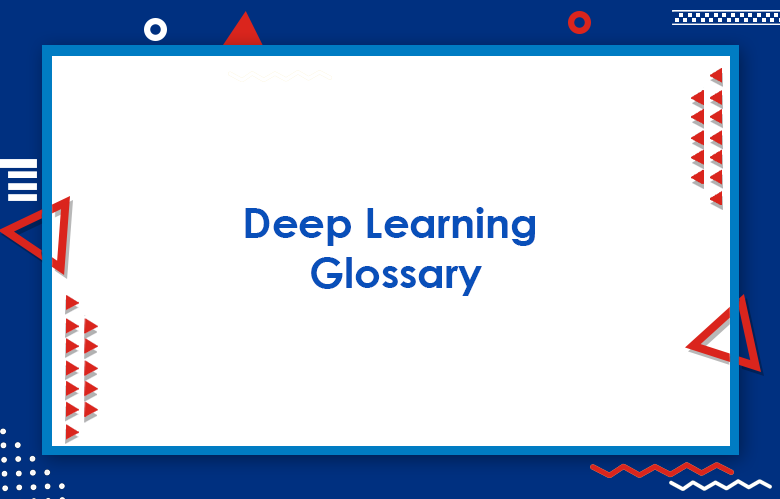Deep Learning Glossary: Machine Learning Terms Definitions & Acronyms

Machine learning is a rapidly growing and exciting industry with endless applications. Deep learning terms are pretty typical to newcomers. The DL glossary below defines the commonly used words and resources to help readers dive deeper into specific topics. As a developer, would you like to learn more about Machine learning? This guide will help you best in your learning process. It includes revised and updated terms. Every professional needs a handy reference.
Deep Learning Glossary: Machine Learning Terms Definitions & Acronyms
A comprehensive Deep Learning Glossary is a valuable resource for those seeking to understand the complex world of machine learning, deep learning, and artificial intelligence. This Glossary provides concise definitions and explanations for essential terms, acronyms, and concepts in the field, making it an indispensable guide for students, researchers, and professionals.
Deciphering Deep Learning: A Comprehensive Glossary of Machine Learning Terminology
Machine Learning Demystified: A Deep Dive into Key Terms and Acronyms
The A-Z of Deep Learning: Understanding Essential Machine Learning Definitions
Unraveling the Jargon: A Guide to Machine Learning Terms and Acronyms
-
Machine Learning Fundamentals: Overview of key concepts, such as supervised, unsupervised, and reinforcement learning.
-
Neural Networks: Explanations of artificial neural networks, deep learning architectures, and activation functions.
-
Training and Optimization: Definitions of terms related to model training, optimization, and evaluation, including backpropagation, gradient descent, and loss functions.
-
Data Processing: This section provides an overview of techniques used to prepare data for machine learning models, such as normalization, feature extraction, and dimensionality reduction.
-
Natural Language Processing (NLP): Introduction to NLP-related terms and concepts, including language models, word embeddings, and sentiment analysis.
-
Computer Vision: Explanations of computer vision terminology, like image segmentation, object detection, and image classification.
-
Reinforcement Learning: Overview of key concepts and terms in reinforcement learning, such as agents, environments, rewards, and policies.
-
Ethics and Fairness in AI: This section discusses concepts related to responsible AI development and deployment, such as bias, interpretability, and privacy.
Mastering Machine Learning: An In-Depth Glossary of Key Concepts
Deep Learning Glossary
Activation Function
A/B testing
Accuracy
Action
Active learning
AdaGrad
Adam Optimization
Agent
Agglomerative clustering
AI Agent
Algorithm
AlphaGo
AR
The area under the PR curve
The area under the ROC curve
Artificial general intelligence
Artificial Intelligence (AI)
Attribute
AUC (Area under the ROC Curve)
Augmented reality
Automation bias
Autonomous
Average precision
Back Propagation
Backpropagation
Bag of words
Baseline
Batch
Batch normalization
Batch size
Bayesian neural network
Bellman equation
Bias (ethics/fairness)
Bias (math)
Bigram
Binary classification
Binning
Black box
Boosting
Bot
Bounding box
Broadcasting
Bucketing
Calibration layer
Candidate generation
Candidate sampling
Categorical data
Centroid
Centroid-based clustering
Checkpoint
Class
Classification model
Classification threshold
Class-imbalanced dataset
Clipping
Cloud TPU
Clustering
Co-adaptation
Collaborative filtering
Computational learning theory
Computer program
Computer science (CS)
Computer Vision
Confirmation bias
Confusion matrix
Continuous feature
Convenience sampling
Convergence
Convex function
Convex optimization
Convex set
Convolution
Convolutional filter
Convolutional layer
Convolutional Neural Network
Convolutional neural network (CNN)
Convolutional operation
Cost
Cost Function
Counterfactual fairness
Coverage bias
Crash blossom
Critic
Cross-entropy
Cross-validation
Custom Estimator
Data
Data analysis
Data augmentation
Data Cleansing
Data mining
Data Science
Data set or dataset
DataFrame
Dataset API (tf. data)
Datasets
Decision boundary
Decision threshold
Decision tree
Deep learning
Deep model
Deep neural network
Deep neural network (DNN)
Deep Q-Network (DQN)
Demographic parity
Dense feature
Dense layer
Depth
Depthwise separable convolutional neural network (sepCNN)
Device
Dimension reduction
Dimensional reduction
Dimensions
Discrete feature
Discriminative model
Discriminator
Disparate impact
Disparate treatment
Divisive clustering
Downsampling
DQN
Dropout regularization
Dynamic model
Eager execution
Early stopping
Embedding space
Embeddings
Empirical risk minimization (ERM)
Ensemble
Environment
Episode
Epoch
Epsilon greedy policy
Equality of opportunity
Equalized odds
Estimator
Example
Experience replay
Experimenter’s bias
Explainable AI
Exploding gradient problem
Fairness constraint
Fairness metric
False-negative (FN)
False-positive (FP)
False-positive rate (FPR)
Feature
Feature column (tf.feature_column)
Feature cross
Feature engineering
Feature extraction
Feature set
Feature spec
Feature vector
Federated learning
Feedback loop
Feedforward Neural Network
Feedforward neural network (FFN)
Few-shot learning
Fine-tuning
Forget gate
Full softmax
Fully connected layer
GAN
Generalization
Generalization curve
Generalized linear model
Generative adversarial network (GAN)
Generative adversarial networks (GANs)
Generative model
Generator
Gradient
Gradient clipping
Gradient Descent
Graph
Graph execution
Greedy policy
Ground truth
Group attribution bias
Hashing
Heuristic
Heuristics
Hidden layer
Hierarchical clustering
Hinge loss
Holdout data
Hyperparameter
Hyperplane
i.i.d.
Image recognition
Imbalanced dataset
Implicit bias
Incompatibility of fairness metrics
Independently and identically distributed (i.i.d)
Individual fairness
Inference
In-group bias
Input
Input function
Input layer
Instance
Intelligence
Interpretability
Inter-rater agreement
Intersection over union (IoU)
IoU
Item matrix
Items
Iteration
Keras
Kernel Support Vector Machines (KSVMs)
Key points
K-means
K-median
L1 loss
L1 regularization
L2 loss
L2 regularization
Label
Labeled example
Lambda
Landmarks
Layer
Layers API (tf. layers)
Learning rate
Least squares regression
Linear Algebra
Linear model
Linear regression
Log Loss
Logistic regression
Logits
Log-odds
Long Short-Term Memory (LSTM)
Long Short-Term Memory Network (LSTM)
Long short-term memory networks (LSTMs)
Loss
Loss curve
Loss surface
LSTM
Machine learning (ML)
Machine learning model
Machine perception
Majority class
Markov decision process (MDP)
Markov property
Matplotlib
Matrix factorization
Mean Absolute Error (MAE)
Mean Squared Error (MSE)
Metric
Metrics API (tf. metrics)
Mini-batch
Mini-batch stochastic gradient descent (SGD)
Minimax loss
Minority class
ML
MOST
Model
Model Capacity
Model function
Model training
Momentum
Multi-class classification
Multi-class logistic regression
Multilayer Perceptron (MLP)
Multinomial classification
NaN trap
Natural Language Processing (NLP)
Natural language understanding
Negative class
Neural Network
Neuron
N-gram
NLU
Node (neural network)
Node (TensorFlow graph)
Noise
Non-response bias
Normalization
Numerical data
NumPy
Objective
Objective function
Offline inference
One-hot encoding
One-shot learning
One-vs.-all
Online inference
Operation (op)
Optimizer
Out-group homogeneity bias
Outliers
Output layer
Overfitting
Pandas
Parameter
Parameter Server (PS)
Parameter update
Partial derivative
Participation bias
Partitioning strategy
Perceptron
Performance
Perplexity
Pipeline
Policy
Pooling
Positive class
Post-processing
PR AUC (area under the PR curve)
Precision
Precision-recall curve
Prediction
Prediction bias
Predictive parity
Predictive rate parity
Premade Estimator
Preprocessing
Pre-trained model
Prior belief
Proxy (sensitive attributes)
Proxy labels
PyTorch
Q-function
Q-learning
Quantile
Quantile bucketing
Quantization
Queue
Random forest
Random policy
Rank (ordinality)
Rank (Tensor)
Rater
Recall
Recommendation system
Rectified Linear Unit (ReLU)
Recurrent Neural Network
Recurrent neural network (RNN)
Regression model
Regularization
Regularization rate
Reinforcement learning (RL)
Replay buffer
Reporting bias
Representation
Re-ranking
Return
Reward
Ridge regularization
RNN
ROC (receiver operating characteristic) Curve
Root directory
Root Mean Squared Error (RMSE)
Rotational invariance
Sampling bias
SavedModel
Saver
Scalar
Scaling
Scikit-learn
Scoring
Selection bias
Semi-supervised learning
Sensitive attribute
Sentiment analysis
Sequence model
Serving
Session (tf. session)
Shape (Tensor)
Sigmoid function
Similarity measure
Size invariance
Sketching
Softmax
Sparse feature
Sparse representation
Sparse vector
Sparsity
Spatial pooling
Squared hinge loss
Squared loss
State
State-action value function
Static model
Stationarity
Step
Step size
Stochastic gradient descent (SGD)
Stride
Structural risk minimization (SRM)
Subsampling
Summary
Supervised machine learning
Supervised Neural Network
Synthetic feature
Tabular Q-learning
Target
Target network
Temporal data
Tensor
Tensor Processing Unit (TPU)
Tensor rank
Tensor shape
Tensor size
TensorBoard
TensorFlow
TensorFlow Playground
TensorFlow Serving
Termination condition
Test set
tf.Example
tf. keras
Time series analysis
Timestep
Torch
Tower
TPU
TPU chip
TPU device
TPU master
TPU node
TPU Pod
TPU resource
TPU slice
TPU type
TPU worker
Training
Training set
Trajectory
Transfer learning
Translational invariance
Trigram
True negative (TN)
True positive (TP)
Actual positive rate (TPR)
Turing test
Unawareness (to a sensitive attribute)
Underfitting
Unlabeled example
Unsupervised machine learning
Unsupervised Neural Network
Upweighting
User matrix
Validation
Validation set
Vanishing Gradient Problem
Wasserstein loss
Weight
Weighted Alternating Least Squares (WALS)
Wide model
Width
Word Embedding
Conclusion:
The Deep Learning Glossary: Machine Learning Terms Definitions & Acronyms is an indispensable resource for individuals looking to navigate the complex and rapidly evolving world of machine learning and deep learning. This Glossary enables readers to deepen their understanding of these cutting-edge technologies and their applications by providing concise definitions, explanations, and acronyms for essential terms and concepts.
Companies and more people are learning about the uses of deep learning technology, and relevant tools are becoming increasingly available. Machine learning has become a more significant part of everyday life. By reading the above Deep Learning Glossary, you will understand the interactions and processes in various industries.
Call: +91 9848321284
Email: [email protected]



